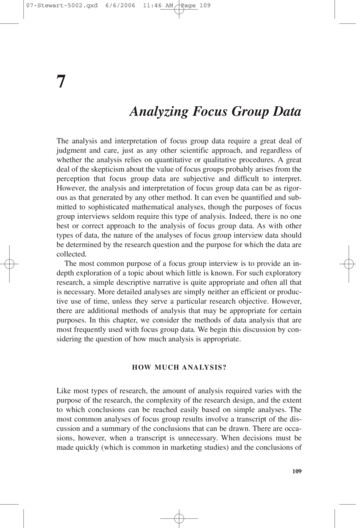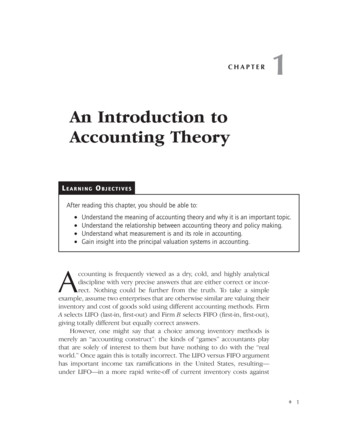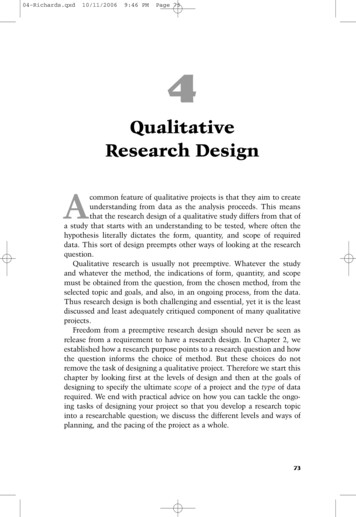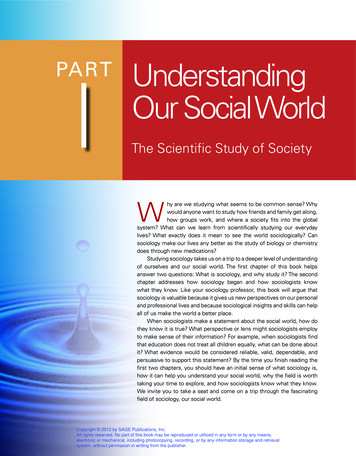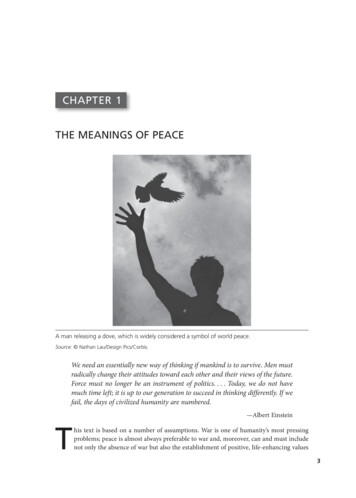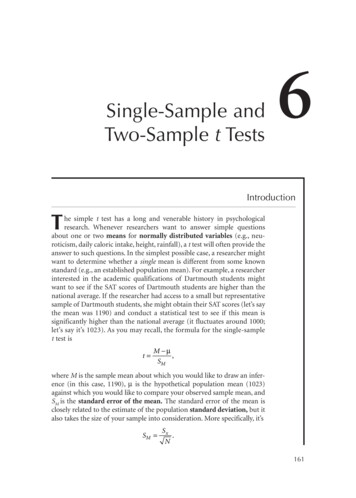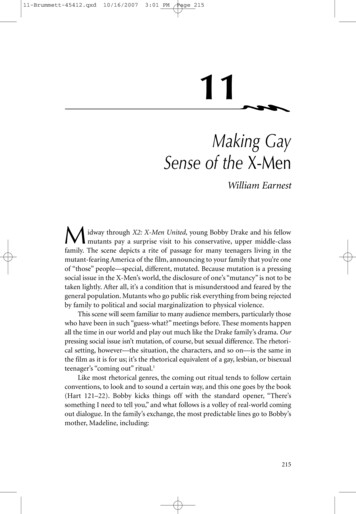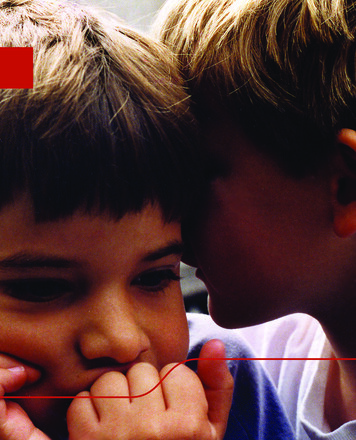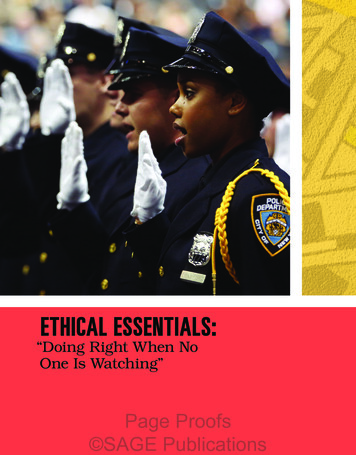
Transcription
ETHICAL ESSENTIALS:“Doing Right When NoOne Is Watching”Page Proofs SAGE Publications
LEARNING OBJECTIVESAs a result of reading this chapter, the student will be able to:1Articulate legitimate ethical dilemmas that arise withpolice, courts, and corrections practitioners2Describe the codes and canons of ethics that exist inpolice, courts, and corrections3Explain the philosophical foundations that underlie andmold modern ethical behavior4Explain why the “ends justify means” type of thinkingposes problems for criminal justice and society5678Discuss and provide examples of absolute and relative ethics9Delineate the unique kinds of ethical considerations andobligations that exist with federal employees10Define noble cause corruptionReview the utilitarian approach to ethicsClarify the controversy surrounding the acceptance ofgratuities, as well as a proposed model for determiningwhether or not such acceptance is corrupt in natureDiscuss the need for, and application of, ethical standards asthey concern police, courts, and corrections practitionersCHAPTER04Page Proofs SAGE Publications
80PART I Criminal Justice as a System: The BasicsWatch your thoughts, for they become words.Watch your words, for they become actions.Watch your actions, for they become habits.Watch your habits, for they become character.Watch your character, for it becomes your destiny.—UnknownINTRODUCTIONAs regular practice is essential to being a renowned musician, and a perfectcake is to a beautiful wedding, so too is ethics essential to being a criminaljustice practitioner. A Latin term that might be used to describe this relationship is sine qua non—“without which, nothing.” Given that, a fundamentalknowledge of ethics, as well as some guideposts concerning what constitutesunethical behavior, is an important topic in today’s society and for all criminal justice students—not only to guide their own behavior but also in light ofthe fact that unethical behavior at times appears to permeate the spheres ofcontemporary U.S. politics/government, business, and sports.What specific behaviors are clearly unethical for criminal justice employees? What kinds of criteria should guide these employees in their work? Towhat extent, if any, should the public allow criminal justice employees to violate citizens’ rights in order to maintain public order?This chapter attempts to address these questions and examine many typesof ethical problems that can and do arise in police departments, courts, andcorrections agencies. The focus will necessarily be on the police, who willfind themselves in many more situations where corruption and brutality canoccur than will the judges and corrections personnel.This is not a black-and-white area of study; in fact, it will be seen thatthere is definitely a “shade of gray” for many people where ethics is called intoquestion. Also problematical is that some people who are hired into criminalASSESS YOUR AWARENESS:Test your knowledge of ethics by first reading and responding to the following seven true-false items; checkyour answers after reading this chapter’s materials.1.The term ethics is rooted in the ancient Greekidea of character.5.The receipt of gratuities by criminal justicepersonnel is a universally accepted practice.2.The “ends justify the means” philosophy isnormally a good, safe philosophy for the policeand judges to follow.6.Whistleblowers exposing improper acts of theircoworkers now enjoy no legal protection.3.At times, communities seemingly toleratequestionable police behavior, if there is a greaterpublic good (such as dealing with violent gangmembers).7.Because of their constitutional obligations,prosecutors and defense attorneys are not boundto ethical standards as are other criminal justiceemployees.4.During an oral interview, applicants for policingjobs should never state that they would bewilling to “snitch out” another officer whom theyobserve doing something wrong.Answers can be found on page 401.Page Proofs SAGE Publications
Ethical Essentials: “Doing Right When No One Is Watching” CHAPTER 4justice positions simply are not of good character. Furthermore, as stated inChapter 1, we cannot train people to have high ethical standards; nor can weinfuse ethics intravenously. In sum, character and ethics are largely something that someone either has or does not have.Included are several scenarios and activities, providing you with opportunities to put the chapter’s materials into practice; among them are several“learn by doing” exercises. Note, too, that police brutality, judicial misconduct, and related problems in corrections will be discussed in Chapters 6, 10,and 13, respectively.GOOD EXAMPLES OF BAD EXAMPLESTo frame the concept of ethics and demonstrate how one’s value system caneasily be challenged in criminal justice work, consider the following scenarios, all of which are true, and what might be an appropriate punishment (ifany) for each (outcomes for each are provided in the notes at chapter’s end): Police: Upon seeing a vehicle weaving across the center line of the highway, Officer A stops the car, approaches the driver’s door, and immediately detects a strong odor of alcohol. The motorist is removed from thecar and joins Officer A and a backup, Officer B, on the roadside. OfficerA decides to use a portable breath test device to confirm his suspicions ofdriving under the influence, or DUI, and he gives a sterile plastic mouthpiece to the driver to blow into. The driver attempts to thwart the testby appearing (but failing) to blow into the mouthpiece. Irritated by thisattempt, Officer A yanks the mouthpiece away, throws it on the ground,and arrests the driver for DUI. At trial, the driver claims the mouthpiecewas flawed (blocked) so he was unable to blow through it; Officer A testifies under oath that it was not blocked, and as “evidence,” he takes amouthpiece out of his pocket, stating it is the mouthpiece he used for thetest that night. Officer B, sitting in the room, hears this testimony andknows differently, having seen Officer A impatiently throw the mouthpiece on the ground and leave it at the scene.1 Courts: For several weeks, a wealthy divorcée receives menacing telephone calls that demand dates and sexual favors. The caller’s voice is electronically disguised. The suspect also begins stalking the woman. Afterworking some clues and tailing a suspect, a federal agent finally makescontact with a suspect, determining that he is the chief judge of the state’ssupreme court. Upon confronting him, the agent is told by the judge to“forget about it, or you’ll be checking passports in a remote embassy.”2 Corrections: A corrections officer in a minimum-security facility foryoung offenders is working the night shift when a youth is admitted. Theyouth is frightened because this is his first time in custody, and the officer places him in isolation because the youth told the staff he is feelingsuicidal. Over the next several days, the officer develops a friendship withthe youth. Looking through the youth’s file, the officer learns that theboy does not wish to remain male; rather, he wants to become a female.One day while doing a routine cell search, the officer observes the youthstuffing women’s panties into his pillowcase. With a terrified and pleading look, the youth explains he prefers them to boxer shorts and begs theofficer not to mention this incident to other staff or youths in the facility.The officer ponders what to do; surely the boy would be seriously ridiculed if others knew of the panties, and it does not seem to be a “big deal.”Page Proofs SAGE Publications81
82PART I Criminal Justice as a System: The BasicsOn the other hand, if the officer does not report the event and the boy’schoice of underwear is revealed later, the officer knows he will be accusedof being lax and not watching over the youths as he should have, and atthe very least lose credibility with other staff and the administration.3PHILOSOPHICAL FOUNDATIONSEthics: a set of rules or valuesthat spell out appropriate humanconduct.Deontological ethics: one’sduty to act.Gratuities: the receipt of somebenefit (a meal, gift, or someother favor) either for free or for areduced price.Absolute ethics: the type ofethics where there are only twosides—good or bad, black orwhite; some examples wouldbe unethical behaviors such asbribery, extortion, excessiveforce, and perjury, which nearlyeveryone would agree areunacceptable for criminal justicepersonnel.The term ethics is rooted in the ancient Greek idea of character. Ethics involvesdoing what is right or correct and is generally used to refer to how peopleshould behave in a professional capacity. Many people would argue, however,that no difference should exist between one’s professional and personal behavior. Ethical rules of conduct should apply to everything a person does.A central problem with understanding ethics concerns the questions of“whose ethics” and “which right.” This becomes evident when one examinescontroversial issues such as the death penalty, abortion, use of deadly force, andgun control. How individuals view a particular controversy largely dependson their values, character, or ethics. Both sides of controversies such as thesebelieve they are morally right. These issues demonstrate that to understandbehavior, the most basic values must be examined and understood.Another area for examination is deontological ethics, which does notconsider consequences but instead examines one’s duty to act. The word deontology comes from two Greek roots, deos, meaning “duty,” and logos, meaning “study.” Thus, deontology means the study of duty. When police officersobserve a violation of law, they have a duty to act. Officers frequently use thisas an excuse when they issue traffic citations that appear to have little utilityand do not produce any great benefit for the rest of society. For example,when an officer writes a traffic citation for a prohibited left turn made at twoo’clock in the morning when no traffic is around, the officer is fulfilling adepartmental duty to enforce the law. From a utilitarian standpoint (where wejudge an action by its consequences), however, little if any good was served.Here, duty and not good consequences was the primary motivator.Immanuel Kant, an 18th-century philosopher, expanded the ethics ofduty by including the idea of “good will.”4 People’s actions must be guidedby good intent. In the previous example, the officer who wrote the trafficcitation for an improper left turn would be acting unethically if the ticket wasa response to a quota or some irrelevant motive. On the other hand, if thecitation was issued because the officer truly believed that it would result insome good outcome, it would have been an ethical action.Some people have expanded this argument even further. Richard Kania5argued that police officers should be allowed to freely accept gratuities becausesuch actions would constitute the building blocks of positive social relationships between the police and the public. In this case, duty is used to justifywhat under normal circumstances would be considered unethical. Conversely,if officers take gratuities for self-gratification rather than to form positive community relationships, then the action would be considered unethical by many.Types of EthicsEthics usually involves standards of fair and honest conduct; what we callconscience, the ability to recognize right from wrong; and actions that aregood and proper. There are absolute ethics and relative ethics. Absoluteethics has only two sides—something is either good or bad, black or white.Some examples in police ethics would be unethical behaviors such as bribery,extortion, excessive force, and perjury, which nearly everyone would agree areunacceptable behaviors by the police.Page Proofs SAGE Publications
Ethical Essentials: “Doing Right When No One Is Watching” CHAPTER 483Relative ethics is more complicated and can have a multitude of sides with varying shades of gray. What is considered ethical behavior by one person may be deemed highlyunethical by someone else. Not all ethical issues are clear-cut,however, and communities do seem willing at times to tolerateextralegal behavior if there is a greater public good, especiallyin dealing with problems such as gangs and the homeless. Thiswillingness on the part of the community can be conveyed tothe police. Ethical relativism can be said to form an essentialpart of the community policing movement, discussed morefully later.A community’s acceptance of relative ethics as part ofcriminal justice may send the wrong message: that there arefew boundaries placed on justice system employee behaviors and that, at times, “anything goes” in their fight againstcrime. As John Kleinig6 pointed out, giving false testimonyto ensure that a public menace is “put away” or illegallywiretapping an organized crime figure’s telephone mightsometimes be viewed as “necessary” and “justified,” thoughillegal; this is the essence of the crime control model ofcriminal justice (discussed in Chapter 1). Another exampleis that many police believe they are compelled to skirt alongthe edges of the law—or even violate it—in order to arrestdrug traffickers. The ethical problem here is that even if theaction could be justified as morally proper, it remains illegal.For many persons, however, the protection of society overrides other concerns.This viewpoint—the “principle of double effect”—holdsthat when one commits an act to achieve a good end and aninevitable but intended effect is negative, then the act might bejustified. A long-standing debate has occurred about balancingthe rights of individuals against the community’s interest incalm and order.These special areas of ethics can become problematic andOne of the ethical responsibilities of police officers iscontroversial when police officers use deadly force or lie andto testify truthfully in court concerning what they saw,deceive othe
cake is to a beautiful wedding, so too is ethics essential to being a criminal justice practitioner. A Latin term that might be used to describe this relation - ship is . sine qua non —“without which, nothing.” Given that, a fundamental knowledge of ethics, as well as some guideposts concerning what constitutesFile Size: 5MBPage Count: 24


